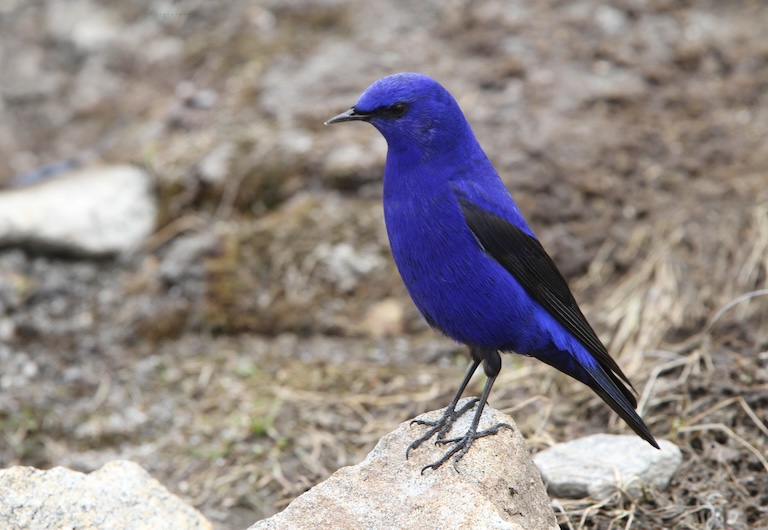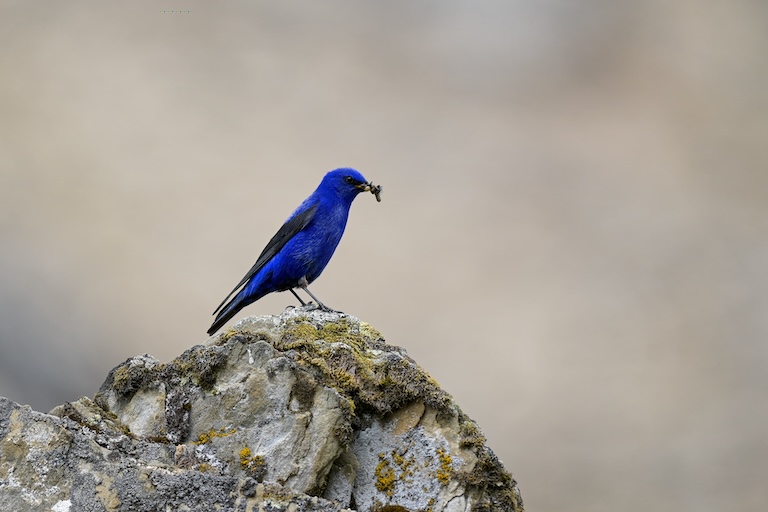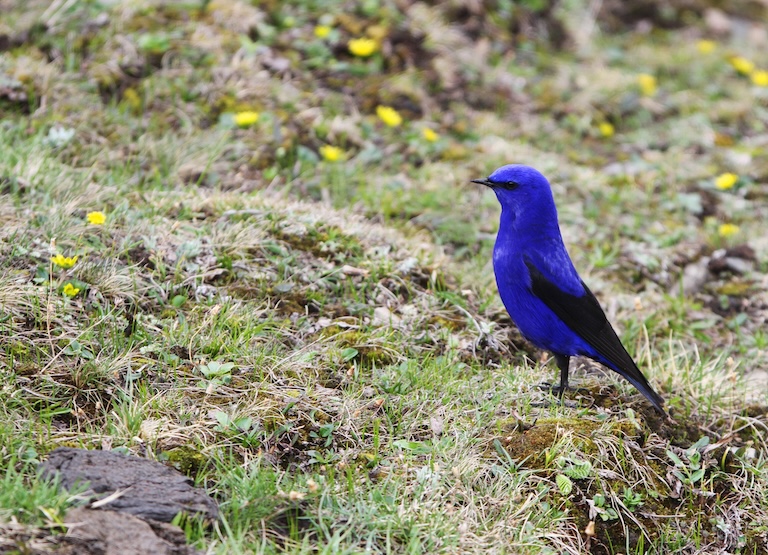Grandala Profile
The eastern Himalayas is a unique ecosystem, as delicate as it is inaccessible, at least to humans.
Many animals migrate not across latitudes or longitudes but altitudes, retreating down into the relative safety of the valleys as the frigid Winters hit the peaks and returning to the moors and wetlands above the treeline as it passes.
One such species is the Grandala, an animal so vibrant and plentiful in this region that its lack of representation in scientific literature and twitcher circles is a reminder of just how vast and unforgiving some places are to human life.

Grandala Facts Overview
| Habitat: | Rocky areas, grasslands, forests |
| Location: | Bhutan, India, Myanmar, Nepal, Tibet and China |
| Lifespan: | Unknown |
| Size: | 23 cm long |
| Weight: | 53 g |
| Colour: | Male is blue with a black tail and wings, female dull speckled grey-brown |
| Diet: | Insects and berries |
| Predators: | Raptors |
| Top Speed: | Unknown |
| No. of Species: | 1 |
| Conservation Status: | Least Concern (IUCN) |
The Grandala is such a blue bird, it deserves to take this title from its North American cousin. Now known to be a thrush, it’s had a convoluted taxonomical history on account of it behaving like a starling and looking like a swallow.
Combined with the fact that it lives at extremely high altitudes, there’s scant information about this species, though it does appear to be doing well, flocking in great numbers and likely contributing invaluable dispersal services to its host plants.
Interesting Grandala Facts
1. They’re thrushes
Grandalas are now known to be members of the unfortunately-named Turdidae, or thrush family. This is a tumultuous family whose members have historically been thrown together and then rejected over time.
Chats and European robins are two of the better-known outcasts, now comprising families of their own, but Grandalas are more or less secure now, having been checked at the molecular level and should stay put.
As thrushes, they’re highly insectivorous, but they also eat fruit. Unlike most thrushes, though, these are primarily arboreal. And that’s not the only strange thing about them.

2. But they’re unusual
This species has a really long wing-tip, which gives it an unusual appearance compared with other thrushes. As it soars around, it has an elegant, swallow-like silhouette, and far more like the starling, is almost always seen as part of an enormous group.
Spotted in stunning aggregations of birds, these gregarious animals form enormous flocks, often, apparently, setting off from and returning to their trees seemingly just for the fun of it.
These large flocks help protect from predators, making it harder for raptorial birds to isolate and pursue any individual grandala.
But the most obvious and striking element of this species is their colour. 1 2
3. They’re blue
Grandalas are some of the most incredible birds to look at, simply because of how blue they are. Blue is already a rare colour in the natural world, but the vibrance shown in this species is almost unique.
Contrasted against stark black wings, this colouration represents the fitness of the males and isn’t present in the females, whose job it is to choose the bluest mate.
Flocks of grandalas are dotted with the dull brown females interspersed between the electric blue males, flocking around snow-dusted treetops in the stunning Himalayan vistas. 3
4. They’re high-altitude specialists
Being a Himalayan species, they have adapted to the dizzying heights of their world. In the summer, they spread as far up as 6,600 metres, feeding well above the treeline on the insects spawning in the heathland.
But as the seasons change, the temperature drops, and huge flocks will descend to warmer regions. Still, their Winter feeding grounds are usually above 3,000 metres up!

5. And can handle cold temperatures
At this altitude, it’s cool even in the Summer.
When Autumn rolls around in the Himalayas, the sea buckthorn’s fruits emerge. This is a shrub that’s a specialist itself, able to withstand temperatures below -40 degrees Celsius.
Around this time, the grandalas, migrating to lower altitudes to avoid the worst of the Winter, arrive to take advantage and gather in their huge flocks to feed on the fruits.
These conditions are hard for mammals, let alone humans, to thrive in, and this is why the species, despite its prevalence and spectacular image, is studied so little. 4
6. They’re not well-studied
Much of the original literature on these birds has yet to be improved upon. Descriptions of their flocking behaviour, vibrant colouration and seasonal vertical migrations remain the body of information available on the species, dating as far back as the 19th Century.
Very little has been done since then to determine more about their breeding, behaviours, or ecological roles, though it’s likely their preference for berries makes them a critical seed disperser of their target trees.
One thing that’s relatively new is the certainty of their position in the Thrush family. 5
7. They were once thought distinct from thrushes
For obvious reasons, the grandala’s position wasn’t certain for a long time, even in the family that had plenty of other groups wrongly lumped into it.
Beginning with the thrushes, it was claimed to be in its own family, as it was claimed to be distinct and unrelated to both the thrushes and any other Passerine family and is not an intermediate but a totally new grouping.
But with strong objections suggesting it belongs with the chats, who were also subsequently rejected from the family, the debate was ongoing.
Even now, the position of the genus remains unclear, but DNA evidence does strongly suggest grandalas belong roughly where they sit, in Turdidae.
Grandala Fact-File Summary
Scientific Classification
| Kingdom: | Animalia |
| Phylum: | Chordata |
| Class: | Aves |
| Order: | Passeriniformes |
| Family: | Turdidae |
| Genus: | Grandala |
| Species: | coelicolor |
Fact Sources & References
- Desfayes, M. (2008), “FIELD NOTES ON GRANDALA COELICOLOR”, Sci Hub.
- N.J. Collar (2004), “Asian enigmas: Four odd ‘thrushes”, Oriental Bird Club.
- Nell Lewis (2023), “Powerful images from environmental photography prize show challenges and hope”, cnn style.
- Roundglass Sustain (2021), “The Grandala Blues”, YouTube.
- Dr Asad Rahmani (2023), “The Grandala: Flying Blue Gem of the Himalayas”, roundglass sustain.
